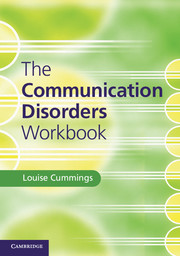Book contents
- Frontmatter
- Contents
- Preface
- Acknowledgements
- List of data analysis exercises
- Chapter 1 Introduction to communication disorders
- Chapter 2 Developmental speech disorders
- Chapter 3 Developmental language disorders
- Chapter 4 Communication disorders in mental illness
- Chapter 5 Acquired speech disorders
- Chapter 6 Acquired language disorders
- Chapter 7 Disorders of voice
- Chapter 8 Disorders of fluency
- Chapter 9 Hearing disorders
- Answers to questions and exercises
- Glossary
- References
- Index
- References
Chapter 1 - Introduction to communication disorders
Published online by Cambridge University Press: 05 June 2014
- Frontmatter
- Contents
- Preface
- Acknowledgements
- List of data analysis exercises
- Chapter 1 Introduction to communication disorders
- Chapter 2 Developmental speech disorders
- Chapter 3 Developmental language disorders
- Chapter 4 Communication disorders in mental illness
- Chapter 5 Acquired speech disorders
- Chapter 6 Acquired language disorders
- Chapter 7 Disorders of voice
- Chapter 8 Disorders of fluency
- Chapter 9 Hearing disorders
- Answers to questions and exercises
- Glossary
- References
- Index
- References
Summary
Human communication is a complex activity that draws on a diverse set of linguistic, cognitive and motoric skills. These skills are the basis upon which speakers (and writers) generate appropriate communicative intentions, encode and decode linguistic utterances and program and execute the motor movements that are needed to produce those utterances. An understanding of these skills and how they contribute to the formulation and comprehension of linguistic utterances is a prerequisite for the study of communication disorders.
The study of communication disorders also requires an understanding of a number of key clinical distinctions. A communication disorder may have its onset in the developmental period. Alternatively, normally acquired speech and language skills may be disrupted by illnesses and events in late childhood and adulthood. The distinction between a developmental and an acquired communication disorder has implications for all aspects of the management of a communication disorder. Similarly, clinicians recognize a distinction between speech disorders and language disorders and, within language disorders, a distinction between expressive and receptive language impairments. A client may exhibit all of these disorders, or just one.
- Type
- Chapter
- Information
- The Communication Disorders Workbook , pp. 1 - 9Publisher: Cambridge University PressPrint publication year: 2014



